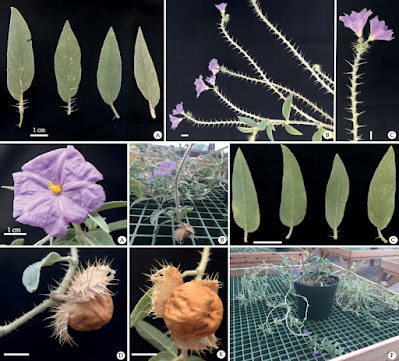 |
| Solanum scalarium Martine & T.M.Williams, in Williams, Hayes, McDonnell, Cantley, Jobson & Martine, 2022. |
Abstract
A new species of functionally dioecious bush tomato of Solanum subgenus Leptostemonum is described. Solanum scalarium Martine & T.M.Williams, sp. nov., is a member of the taxonomically challenging “Kimberley dioecious clade” in Australia and differs from other species in the group in its spreading decumbent habit and conspicuously prickly male floral rachis. The species is so far known from one site in Judbarra/Gregory National Park in the Northern Territory. Ex situ crosses and confirmation of inaperturate pollen grains produced in morphologically cosexual flowers indicate that these flowers are functionally female and the species is functionally dioecious. The scientific name reflects the ladder-like appearance of the inflorescence rachis armature of male individuals, the stone staircase that provides access to the type locality at the Escarpment Lookout Walk, and the importance of maintaining equitable and safe access to outdoor spaces. The common name Garrarnawun Bush Tomato is proposed in recognition of the lookout point at this site, a traditional meeting place of the Wardaman and Nungali-Ngaliwurru peoples whose lands overlap in this area.
Keywords: Australia, dioecy, inaperturate pollen, Judburra/Gregory National Park, new species, Northern Territory, Solanaceae, Solanum dioicum
Solanum scalarium Martine & T.M.Williams, sp. nov.
Diagnosis: This species is distinguished from Solanum dioicum W.Fitzg. (as currently delineated) and other Australian functionally dioecious Solanum species of the “Kimberley dioecious clade” by the combination of a spreading decumbent habit and the staminate inflorescence axis armed with relatively stout, spreading, straight prickles.
Etymology: Latin scalare from scala, ladder or stair, and suffix aris, pertaining to; the epithet scalarium is the genitive plural of scalare, indicating ladder-like appearance of staminate inflorescence rachises, which are conspicuously and unusually armed with relatively stout, spreading, straight prickles resembling ladder steps. It is also a nod to the type locality at the Escarpment Walk, Judbarra/Gregory National Park, where stone stairs lead from the car park up to the habitat of this species. By choosing this name we acknowledge the access these steps provide to the newly-described species as well as the importance of providing broad access to nature, outdoor recreation, and scientific discovery. We suggest the use of Garrarnawun Bush Tomato for the English-language common name of the species in recognition of the Garrarnawun Lookout near where the type collection was made, a traditional meeting place of the Wardaman and Nungali-Ngaliwurru peoples whose lands overlap in this area (Parks and Wildlife Commission of the Northern Territory 2021).
Tanisha M. Williams, Jonathan Hayes, Angela J. McDonnell, Jason T. Cantley, Peter Jobson and Christopher T. Martine. 2022. Solanum scalarium (Solanaceae), A Newly-described Dioecious Bush Tomato from Judbarra/Gregory National Park, Northern Territory, Australia. PhytoKeys. 216: 103-116. DOI: 10.3897/phytokeys.216.85972


